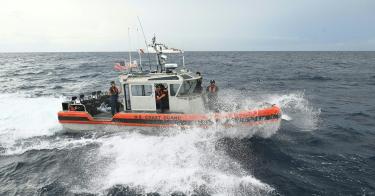The Coast Guard is currently building a ship without a plan.
The Coast Guard’s highest acquisition priority, the offshore patrol cutter program, has risk because construction is underway, but the plans for the ships are not finalized, according to a new Government Accountability Office report.
That represents bad news for an already struggling program.
The delay in the program to replace the increasingly obsolete medium endurance cutters has already put strains on an aging fleet, and as the GAO reports, the program is not set up for success, because designs for the ships being built are not even fully completed yet.
The Coast Guard must align its acquisition policy with shipbuilding leading practices and do so quickly if it wants to bring this program across the finish line in a reasonable time frame.
Offshore patrol cutters will be vital for the Coast Guard, as they serve as the middle-tier vessels in a layered fleet strategy. They are responsible for homeland security, law enforcement, defense, and search-and-rescue operations.
The vessels bridge the gap between the bigger national security cutters, which operate far out to sea in the open ocean, and small fast-response cutters that generally operate closer to shore, providing the backbone of the Coast Guard’s offshore presence.
The offshore patrol cutters’ initial acquisition program was approved in 2012, leading the Coast Guard to select Eastern Shipbuilding Group Inc. for the ship’s detail design. In 2018, the Coast Guard approved the design of the first offshore patrol cutter despite the fact the program had not conducted an independent assessment of the technology and ensured a finalized design.
Currently, the Coast Guard is still using medium endurance cutters to perform many operations, even though those ships should be retiring. Their original service life was intended to be 30 years, which they have now exceeded by 15. Operating them has become more difficult and expensive as the fleet of 28 ships is prone to failure from overuse and requires extensive maintenance.
The capability gap between the retirement of the medium endurance cutters and the deployment of the offshore patrol cutters is increasing, hindering the Coast Guard’s abilities.
From the beginning of construction, the offshore patrol cutter program has been unable to provide thorough and complete designs or maintain a stable schedule to meet deadlines. The primary issue the GAO identified is that the construction phase moved forward before the design phase was fully finished.
This “concurrency” has been proven to increase poor outcomes, delay schedules, and often leads to cost increases. The GAO reported the programs’ total acquisition cost estimate between 2012 and 2022 increased from $12.5 billion to $17.6 billion, a 41% increase.
Recently, the Coast Guard updated its procedures. The updated version is an improvement, but could still be better. The current version states there must be a minimum design maturity of 95% functional design and 70% transitional design before construction starts. In contrast, the National Defense Authorization Act for fiscal year 2022 requires the secretary of the Navy to certify the ships’ basic and functional design are 100% complete before construction.
To hold the Coast Guard accountable for taxpayers’ dollars, the current practice must be to ensure a complete and stable design prior to the start of construction of the first ship and demonstrate all the critical technologies in a realistic environment.
The Coast Guard should make sure its acquisition practices meet the best practices of the shipbuilding industry going forward. By adopting these practices, the Coast Guard can avoid the risk of future programs experiencing the same problems and get its current programs back on track.
The new offshore patrol cutters will help the Coast Guard carry out drug interdictions, combat illegal fishing, and increase cooperation with allies. Having a strong Coast Guard is of utmost importance to the United States and our national interests.
This piece originally appeared in The Daily Signal




